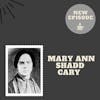Mary Ann Shadd Cary

A woman who lived enough for several lifetimes, Mary Ann Shadd Cary was one of the loudest voices in support of Canadian emigration for Black Americans.
Growing up in a household committed to racial justice, Shadd Cary spent her life turning words into action, becoming the first Black woman to launch a periodical in North America. But she also bucked societal norms, often alienating supporters and potential benefactors.
Join me this week as I dive into the life of Mary Ann Shadd Cary.
SOURCES
“Mary Ann Shadd Cary.” National Parks Service. (LINK)
“Mary Ann Shadd Cary House.” National Parks Service. (LINK)
Rhodes, Jane. Mary Ann Shadd Cary: The Black Press and Protest in the Nineteenth Century. United States: Indiana University Press, 1999.
Specia, Megan. “Overlooked No More: How Mary Ann Shadd Cary Shook Up the Abolitionist Movement.” June 6, 2018. The New York Times. (LINK)
Yee, Shirley J. “Finding a Place: Mary Ann Shadd Cary and the Dilemmas of Black Migration to Canada, 1850-1870.” Frontiers: A Journal of Women Studies 18, no. 3 (1997): 1–16. https://doi.org/10.2307/3347171.
Welcome to Civics and Coffee. My name is Alycia and I am a self-professed history nerd. Each week, I am going to chat about a topic on U.S history and give you both the highlights and occasionally break down some of the complexities in history; and share stories you may not remember learning in high school. All in the time it takes to enjoy a cup of coffee.
INTRO MUSIC
Hey everyone, welcome back.
When you think of black anti-slavery activists in the nineteenth century, many conjure pictures of Frederick Douglass, David Walker, and Sojourner Truth. All three were passionate proponents of black freedom, writing and giving speeches in support of abolition and improving the lives of their fellow countrymen. One name you may not be as familiar with is Mary Ann Shadd Cary.
A woman who managed to squeeze in 3 or 4 lifetimes in one, Cary was an educator, journalist, and a lawyer. She was also a major proponent of black emigration and women’s suffrage. But she remains somewhat of a mystery to many.
So this week, I am diving into the story of Mary Ann Shadd Cary. Who was she? What impact did she have on the fight for black rights? And why is she not more well known?
Grab your cup of coffee, peeps. Let’s do this.
Born into a free family in the slave state of Delaware, Shadd Cary was destined to be an activist. Her family were active participants in the Underground Railroad, helping escaped slaves find freedom in northern ports of call and her father was prominent in abolitionist circles, including attending the American Anti-Slavery Society meetings. This instilled in Mary a keen sense of justice at a young age.
Entering the world on October 9th, 1823, Mary Ann Shadd was the first of thirteen children. Growing up, her family participated in a number of movements aimed at challenging or outright ending slavery and pushed for social reform. The Shadd’s benefitted from a long lineage of mixed race, and her father earned a living in the skilled trades. Few details are known about Mary’s early life, but the same cannot be said about her father, Abraham. He was one of six Black Americans to be named to the American Anti-Slavery Society’s board of managers and as I mentioned there is documentation indicating he was an active participant in the underground railroad. Of course, given how dangerous the ramifications were for participating, the scope of Abraham’s participation remains unclear. While Mary was still a young girl, the family picked up stakes and moved out of the hostile Delaware to Pennsylvania. This undoubtedly only served to further aid Abraham in his railroad activities.
The Shadd’s believed in education and paid to ensure their daughter received one as public schools remained out of reach for young black children during this time. It is believed she was taught by Quakers, who were much more accepting and supportive of black americans. Mary seemed to internalize her family’s message of self uplift and leveraged education to secure her ticket out to economic freedom and to continue the work her family had done throughout her childhood. At just 19, Mary left home, determined to open a school for black children back in her home state of Delaware. She also spent time teaching in New Jersey and Pennsylvania, trying to save enough money to cover the costs associated with starting her own school.
Shadd Cary’s first known foray into the public space was a letter to Frederick Douglass published in his newspaper the North Star. The letter was in response to a request for suggestions from Douglass on how to improve the conditions for free black americans in the north. Foreshadowing what was to become her lifelong ethos, Mary shared her sentiment that black americans needed to find ways to become the producers and not the consumers. In her mind, that was the only way they would ever truly be free from the oppression of white america. In her letter, Shadd Cary suggested black agricultural investment and touted the benefits of education as well as the need to engage in integrated political organizing.
She followed up her letter to Douglass with a twelve-page self-help pamphlet titled “Hints to the Color People of the North.” The short manifesto didn’t get a lot of traction when it was first published, though pieces of her work were printed in Douglass’ newspaper. Mary spent the 1840s honing her writing and developing what would become her public speaking voice, two mechanisms she would utilize consistently throughout her lifetime.
By 1851, Mary was teaching in New York at Primary School Number One. Unfortunately the conditions were less than ideal. The school, if you can call it that, was located in the basement of a church and tried to teach 900 students. Shaddy Cary grew frustrated over the state of affairs for blacks in America and, especially after the Fugitive Slave Act of 1850, felt she could do more good elsewhere. So she picked up stakes once again, this time traveling to Canada, originally settling in Sandwich. She was just 28 years old. She quickly relocated to Windsor where she once again committed herself to opening an integrated school.
With the assistance of the American Missionary Association, Mary was able to open a school in 1851, but found keeping it open to be a challenge. Running a school required funding. While she secured $125 from the Missionary Association, the total costs were double and she was constantly seeking other revenue streams to help support the institution. However, Mary didn’t compromise herself or her beliefs. As a black, educated woman unafraid to operate in the public sphere, she challenged societal norms, often rubbing potential benefactors the wrong way. She fought as hard as she could, but ultimately was forced to close the doors on March 23, 1853.
Never one to sit idle, Mary quickly trained her eye on a new endeavor. Shadd Cary, who had been feuding with escaped slave and newspaper editor Henry Bibb, decided to challenge Bibb’s supremacy as the black journalistic voice in Canada, launching her own newspaper, the Provincial Freeman on March 24, 1853. She remained committed to keeping the paper afloat for several years and it would go down as one of the longest lasting abolitionist newspapers of the period. Launching the paper also made Mary the first black, female newspaper editor in North American history. For Shadd Cary, the goal of her paper was to be the quote “standard-bearer of black emigration,” end quote and was published weekly on Saturdays.
Mary was aggressive in her promotion of the paper which again flew in the face of societal customs. After withstanding a barrage of criticism and pushback, Shadd Cary eventually relented and handed over editorial control of the paper to a man, William P. Newman. She also sought to cut costs for the paper, moving the base of operations from Toronto to Chatham. While working on the Provincial Freeman, Mary also honed her oratory skills by going on the abolitionist speaking circuit.
In 1855, Shadd Cary was one of only two women to attend the Colored National Convention in Philadelphia. During the meeting Mary gave a passionate speech in support of black emigration to Canada. This speech resonated with many in the audience and further increased her national profile, with Frederick Douglass describing it as quote “one of the most convincing and telling speeches in favor of Canadian emigration I ever heard,” end quote. She continued to travel around the United States giving speeches in support of Canadian migration and broke more societal norms by debating a man, Isiah Wears, on November 6th.
The debate, held at the Banneker Institute, was focused on the question quote “Shall the Free Colored People of the United States Emigrate to Canada,” end quote and came as a result of a challenge extended by Wears. An abolitionist born in Philadelphia, Wears worked with the Union African Episcopalian Church. Unfortunately for Wears, Shadd Cary was not to be intimidated and had long held her deeply rooted beliefs that emigration could prove beneficial to black americans. Her arguments carried the days as Mary was voted as the winner of the debate by a three judge panel.
On a personal level, Mary found love, marrying Thomas F. Cary on January 3rd, 1856 at her sister’s home in St. Catherine. Her new husband was also a free man who had emigrated to Canada. Upon their union, Mary became stepmother to his three children Ann, Thomas Jr. and John. Despite the conventional decision to get married and take her husband’s last name, Shadd Cary still bucked the trend, as the couple maintained separate homes for the duration of their marriage. And, perhaps even more surprising, she continued on in her career. She was still trying to make something of her paper, the Provincial Freedom, but finally had to cease publication in 1857 after four years.
As the 1860s dawned and the United States inched closer to Civil War, Mary Shadd Cary faced personal struggles of her own, beginning with the death of her husband. Passing away on November 29, 1860, Thomas Cary was just 35 years old. Making matters worse, Mary was pregnant with their second child. And as she watched the country of her birth split into two factions, Mary put herself to work, returning to the United States to serve as a recruiting officer to convince black americans to join the union army.
In the aftermath of the Civil War, Shadd Cary relocated to the Detroit area and resumed teaching, securing a certification from the Detroit Board of Education in 1868. She picked up stakes one more time, finally settling in Washington, DC in 1869 which would be her final home. She continued with her political activism, but she needed to reset. As Shaddy Cary biographer and historian Jane Rhodes observes, quote: “she was an abolitionist in a world that no longer needed abolitionists; an emigrationist for a people who no longer sought a new homeland,” end quote.
Rechanneling her energy, Shadd Cary leveraged her vast experience to support reconstruction efforts. In 1869, she represented the state of Michigan at the Colored National Labor Meeting where she pushed the cause for women, giving a speech highlighting the work of women in the black labor movement. Never far from her first profession, Mary secured employment as a teacher in one of DC’s schools for black children, becoming principal two years later. As the top administrator, Shadd Cary supervised 25 teachers and aids, who in turn taught between 150 and 200 adult learners each month.
And as if running a school was not enough to keep her sufficiently busy, Mary Shadd Cary decided to add just one more thing to her plate: getting her law degree. Originally founded in 1867, Howard University added a law program to their school in 1869 and Mary was one of 46 students admitted to the first class. She is believed to be the first black woman admitted to law school, working during the day as a teacher and principal while attending law school in the evenings.
Shadd Cary quickly trained her eye on a new cause - women’s suffrage. Always a fan of action over rhetoric, she tried to register to vote in DC in 1871, only to be denied on the account of her gender. She knew would be refused, but did so as part of a civil disobedience strategy to help elevate the cause. Another movement that attracted Mary’s attention was that of temperance. For Mary, sobriety was another way to uplift the lives of black women and support the children she saw every day struggling in her school. For her, drinking was tied to slavery and would only prevent black americans from reaching their full potential and assimilate into the United States.
In 1880, Shadd Cary founded the Colored Women’s League of Washington. Also known as the Colored Women’s Progressive Franchise Association, the organization focused on pushing women to receive vocational training and highlighted the need for women to invest their money. The association hoped to promote political and economic rights for women and encourage them to go into business for themselves. The group established a joint stock company that invested in small businesses, allowing poor people without any capital to borrow what they needed to get started. The group favored business that paved to black self-sufficiency, prioritizing loans for land development and grocery stores.
Shadd Cary had not mellowed in her advanced age, announcing during the first meeting of the association quote “our leaders do not take the women into consideration,” end quote. She further stated that while white women had access to nearly fifty occupations, black women were still economically handicapped, with fewer than a dozen opportunities. For Mary, women’s clubs and organizations were an avenue to secure broader access to citizenship and she leveraged her group as much as she could to secure economic stability for her fellow black americans.
Despite taking nearly fifteen years, Mary Shadd Cary successfully completed her law degree in 1883 at the age of 60. She tried unsuccessfully to launch a legal career, but being a black, female attorney in Washington, DC proved a challenge she simply could not overcome. She finally retired from teaching and spent the last decade of her life living with her children before dying from stomach cancer just a few months shy of her 70th birthday on June 5th, 1893. Her funeral was held at the Israel Metropolitan AME Church and she was initially interred at the Columbian Harmony Cemetery. She was moved nearly six decades after her death when she, along with thousands of other individual remains, were relocated to the National Harmony Park in Landover, Maryland.
Her DC home is listed as a National Historic Landmark, but is not open to the public as of this recording in 2023.
Mary Ann Shadd Cary refused to accept the status quo and lived her life in pursuit of equality and justice. Unafraid to challenge societal expectations, she often alienated others in pursuit of her goals, but refused to back down from what she believed to be the correct course. She did not fit into any predetermined mold and her opinions sometimes put her at odds with her contemporaries, but her voice and her seemingly unbreakable spirit furthered the cause of black americans.
So why isn’t Shadd Cary a household name? Well, it likely is a result of her unwillingness to compromise and to force herself to fit the expectations of the time. Despite her intelligence and commitment to black excellence, she simply proved to be too ahead of her time.
As historian Jane Rhodes astutely observed, Mary Ann Shadd Cary was quote, “a quintessential dissident; a woman whose life was marked by the numerous ways she transgressed the boundaries of sex, color, and class, and the price she paid for the boldness of her actions,” end quote. She may not have said or done things the way others wanted, but she was a woman who achieved a great many things in her nearly seven decades on earth, proving that women belonged in the public sphere.
If you ever have a topic you want me to cover, let me know. You can find me on all the social channels or through the website at www dot civics and coffee dot com. The website is also where you can find source material, transcripts, and information about how you can help support the show.
Thanks, peeps. I’ll see you next week.
Thanks for tuning and I hope you enjoyed this episode of Civics & Coffee. If you want to hear more small snippets from american history, be sure to subscribe wherever you get your podcasts. Thanks for listening and I look forward to our next cup of coffee together.
OUTRO MUSIC
Listener Favorites
Not sure where to begin? Take a listen to some fan favorites.

























